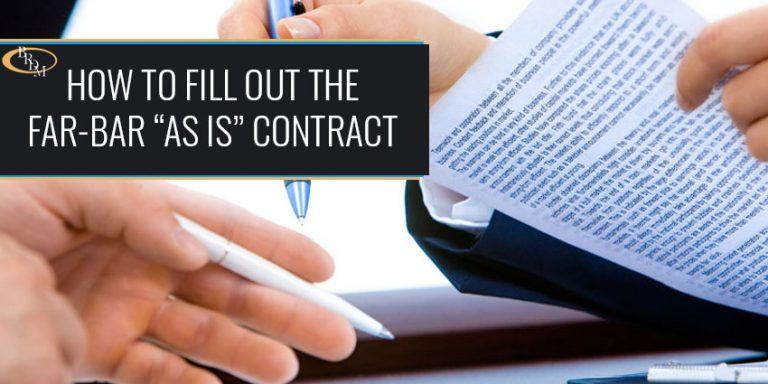The Far-Bar “AS IS” Residential Contract For Sale And Purchase is one of the most important aspects to a real estate transaction. The Florida Bar (BAR) and Florida Association of Realtors (FAR) have collaborated to create a universal form for residential real estate deals known as the “FAR/BAR AS IS Residential Contract For Sale And Purchase” to serve as a standard contract in residential real estate transactions. This standard agreement is considered to be a reliable, comprehensive, and legally binding agreement. In my experience, I have found that many underestimate the complexity and the potential pitfalls of customizing this standard agreement. This article will discuss everything you need to know to complete an accurate and legally binding Far-Bar As-Is Contract that will serve its purpose in a residential real estate transaction. While reading this article, you will want to have a copy of the standard Far-Bar “AS IS” Residential Contract For Sale And Purchase in front of you as I will be referring to specific sections throughout this article.
*(Please note that since the posting of this blog there have been additional changes in the 2021 version of the Far-Bar “AS IS” Residential Contract for Sale And Purchase. For more information on the changes you can read this blog here. For a copy of the new draft: Download 2021 Draft.)
Table of Contents
The Parties
In the first part of the contract you will need to identify the parties to the agreement. This MUST include the legal name of the Seller as it appears on the title of the property and the legal name of the buyer. The biggest pitfall with this area of the contract is that people tend to leave co-owners off of the agreement or mistakenly substitute a person with a trust or a legal entity. To correctly fill out this area, you should refer to the prior deed or “vesting deed” and use the name of the “Grantee” on such deeds. If the property is owned by multiple parties, all parties must be listed on the document (and must eventually sign at the bottom). If the property is owned by a trust, the legal name of the trust must be listed in this area.
Section 1. Property Description
In this section you will identify the property. You need to be careful to tediously identify exactly what you will be purchasing. This area should include the street address, the county, the parcel ID #, and the legal description. Pay careful attention to the legal description and make sure that what you are putting on the contract matches the legal description of the property being sold or acquired. Section 1(d) & (e) pertain to “Personal Property” meaning appliances, window treatments etc. You should review the list of items in the contract. You will need to add or delete items of Personal Property that will be included or excluded from the sale. Please do not assume that something “goes with the house.” If it is not specifically listed, please add it to the contract.
Section 2. Purchase Price
In this area you will list the purchase price, escrow deposit, and financed amount. For sellers, I recommend getting a significant amount of money down that will be “non-refundable” after the inspection period has passed. This will keep the buyer honest and help ensure that after the inspection period has passed that buyer will close.
Section 3 & 4: Time for Acceptance and Closing Date
This area of the contract is fairly straightforward. The only advice I would offer is to be realistic about these deadlines. If the parties are unable to fully execute the contract before the deadline laid out in 3(a), the contract will become “stale” and will need to be revised and re-executed. This can cause undue delays and be quite irritating. As for choosing a closing date, please be realistic about how much time the parties will need to close. If a buyer is seeking financing, I recommend a closing date approximately 45 days from the date the contract is signed.
Section 7. Assignability
This is a somewhat complex component of the contract. Assignability means that Buyer has the right to assign all of his/her/its rights under the contract to another party who will stand in the shoes of the original Buyer. This new party has all rights the Buyer originally had. The question is, is this allowed at all or will Buyer remain responsible for fulfilling the contractual duties after the assignment has been completed. Sellers should be wary of allowing buyers to check the first box of the contract which allows buyer to assign the contract and be released from liability. This could be used to “flip the contract” or it could be used nefariously to assign the contract to a judgment proof person who has no ability or intention to close. If you are going to allow assignment, Sellers should insist that Buyers remain liable so you would check the second (2nd) box.
Section 8. Financing
In this section, the parties will indicate whether the Buyer will pay cash or whether there will be some type of financing. If the Buyer elects to pay cash there will be no “financing contingency.” If Buyer elects financing, Buyer’s obligation to purchase the Property will likely be contingent upon Buyer obtaining financing. Seller should insist that Buyer fill out Section 8 in its entirety meaning listing whether the loan will be conventional, FHA, VA, how long they have to be approved, how many years will the loan be, at what interest rate, how much will be financed. Sellers should also consider whether these numbers are realistic. The last thing that Seller wants is to waste time off of the market for financing that will never get approved because Buyer is seeking 98% financing; I recommend keeping this number around 80% at most.
Section 12. Inspection Clause
This section of the contract is one of the most well-known and focused upon areas. This clause will give Buyer the right to walk away from the deal and receive a return of Buyer’s deposit for any reason. Specifically, this section states that: “if Buyer determines, in Buyer’s sole discretion, that the Property is not acceptable to Buyer, Buyer may terminate this Contract . . .” This is a very powerful language. For this reason, Sellers will want to limit this time period as much as possible. Industry standards generally provide for a 10 – 15 day inspection period in a residential deal.
Signatures
The last section of this Contract that I will discuss is the signature area. Please make sure that all owners of the property and all buyers sign this contract. Also, for entities and trusts, you need to make sure that you have individuals with signing authority execute on behalf of the entity or trust. For a Corporation, this is the President, for an LLC the Manager, for a Trust the Trustee.
If you have any further questions regarding the FAR BAR “AS IS” contract, please contact Andrew R. Pardun.



